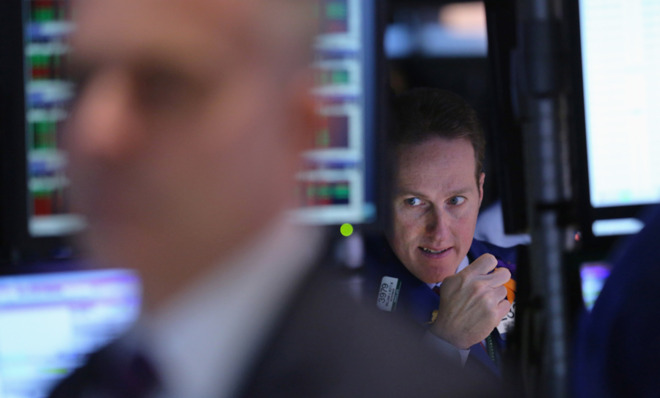Is the stock market really rigged in favor of high frequency traders?
A look at Michael Lewis' new book, Flash Boys: A Wall Street Revolt

In 24 hours, I plowed through Michael Lewis' new blockbuster Flash Boys: A Wall Street Revolt, a book about the huge changes that have occurred in financial markets in the last three decades. It's compelling reading.
Since 1987's Black Monday, markets have become increasingly computerized. Change was gradual at first, but in the last decade it has become rapid. Today, computerized markets trade faster than ever before — faster, literally, than the blink of an eye. Trading is not done just by humans mashing buttons, but also by algorithms, which are programmed to take specific actions based on conditions in the markets.
These changes began to really accelerate in 2005, when at the behest of the Securities and Exchange Commission — responding to public protests about cronyism — public exchanges went from being utilities owned by their members, to corporations run for profit. Once competition was introduced, an array of new exchanges sprung up. By early 2008, there were 13 different public exchanges. And these exchanges are not auditorium-style spaces teeming with shouting traders a la the New York Stock Exchange. They're servers in data centers, most of them clustered in northern New Jersey. Today, there are upwards of 40 public exchanges, as well as a variety of opaque private exchanges — such as Goldman Sachs' Sigma X and Citigroup's CitiMatch — that are known as dark pools.
The Week
Escape your echo chamber. Get the facts behind the news, plus analysis from multiple perspectives.

Sign up for The Week's Free Newsletters
From our morning news briefing to a weekly Good News Newsletter, get the best of The Week delivered directly to your inbox.
From our morning news briefing to a weekly Good News Newsletter, get the best of The Week delivered directly to your inbox.
New companies specializing in high-frequency trading stepped into this brave new world. Traders have long engaged in what is known as arbitrage — making a profit from price differences of the same asset in different markets. If a stock is going for $10 a share in one market and $9.99 in another, then high-frequency traders can buy for $9.99 and sell for $10. That doesn't sound like a huge profit, but over millions of trades, it adds up. And as markets have become faster, the arbitrage has sped up, too.
In fact, it's become so fast that the high-frequency traders since around 2007 have been front-running the market. Say that an investor wants to buy 1,000 shares in Microsoft for $41.37 a share, its current quoted price. He places an order using his online brokerage. The broker sends out a signal to all the exchanges that the investor wants to buy. The time it takes for the data to be transmitted to the different exchanges varies. As soon as the buy signal hits an exchange, this alerts high frequency traders, who are generally operating out of or near the same data centers as the exchanges themselves. If the first exchange cannot fill the order for Microsoft stock, then high-frequency traders will buy up everything offered in the market at $41.37 a share. This means that the order at $41.37 may remain unfilled, and if the investor wants to fill the order, he will have to place a new order for a higher amount, perhaps $41.38, $41.39, or $41.40 per share. Again, this doesn't sound like much, but over billions of trades it can add up to hundreds of millions, even billions, of dollars.
And speed is king. The spoils for high-speed arbitrageurs are distributed overwhelmingly to those with the fastest technology. The longer data has to travel via fiber optic cable, the slower the trade. That means spending millions of dollars building cable lines from Chicago (where futures markets are located) to the East Coast (where most of the high-frequency traders are based). It means paying out the nose to be located in the same data centers as exchanges. And it means — according to Lewis and his industry sources — paying dark pools and exchanges for privileged access to early information on market actions, a claim that financial regulators will certainly want to investigate.
Lewis worries that investors are getting ripped off. But worse, he argues that the cut that high-frequency traders are taking is a drag on the economy. "[The money collected] by financial intermediaries...is a tax on investment, paid for by the economy," he writes, "and the more that productive enterprise must pay for capital, the less productive enterprise there will be."
A free daily email with the biggest news stories of the day – and the best features from TheWeek.com
He's right to worry about all this. It may be inevitable that financial intermediaries will charge for the service of matching productive businesses with investors, but front-running the market and driving up the price is not really providing a service. It's jumping in and grabbing a parasitic cut.
On the other hand, defenders of high-frequency trading say it has brought down the costs. They point to the fact that spreads — the difference between the prices offered to buyers and sellers at any one time — have fallen dramatically since the advent of high-frequency trading, from 1/16th of a percentage point to just 1/100th of a percentage point. This lowers transaction costs for regular investors.
That makes it difficult to agree with Lewis' assertion — which he repeated earlier this week on 60 Minutes — that the stock market is rigged in favor of high-frequency traders, allegations that have already sparked separate FBI and SEC investigations. High-frequency traders have definitely made a massive profit taking advantage of a new, complex system that few have understood properly. But that's not the same thing as rigging the market. Computerization has very much been a double-edged sword for investors. Even with high-frequency traders taking their cut, investors are benefiting from transaction costs that are lower than those of the pre-computerization era.
For as long as there have been stock markets, investors have been looking for an edge. Computerization may have speeded that up, but it's not fundamentally different from earlier times. Financier Nathan Rothschild, for example, made huge profits in 1815, in the days of horses and carrier pigeons, after his informational network gave him an early insight — apparently before even the British government itself knew — that Britain had won the Battle of Waterloo. Getting public information as early as possible and trading on it is not cheating per se.
Lewis is right that stock ownership in the U.S. has fallen considerably since the advent of high-frequency trading. Before 2007, as Lewis notes, "67 percent of U.S. households owned stocks; by the end of 2013, only 52 percent did." But is the complexity of the financial system the cause? Maybe, but there are probably other factors. Trust in banks and financial institutions evaporated after the 2008 financial crisis, for example. Polls revealed that in the wake of the financial crisis Americans were more interested in other kinds of assets, including gold and real estate. (However, as the stock market has recovered, interest in stocks as an investment has revived somewhat.)
But it's probably true that for markets to win back trust, change needs to happen. Lewis' book tells the story of Brad Katsuyama's IEX dark pool exchange, which seeks to reduce the advantage that high-frequency traders enjoy. Among other methods, IEX spools miles of extra fiber-optic cable between the servers and exchanges. So far, IEX has received the support of some brokerages, including Goldman Sachs and Katsuyama's former employer the Royal Bank of Canada.
Yet even if the techniques pioneered at IEX become the norm, and even if the SEC moves to regulate high-frequency traders more strongly, that isn't necessarily going to stop arbitrageurs and ensure a perfectly level playing field. Even radical proposals — like slowing the market down to trade at only one-second intervals — are likely to be ineffective. Arbitrageurs will simply find a new loophole to exploit. As Lewis himself acknowledges, "[E]very systemic market injustice arose from some loophole in a regulation created to correct some prior injustice."
Anyway, it's possible that the high-frequency trading boom is already over. Profits have been falling steadily in the few years since the technique became popular, from almost $5 billion in 2009, to just over $1 billion in 2012. If the profits that can be squeezed out of high speed arbitrage are falling — partly because the tools that investors and brokerages can use to protect themselves are strengthening — then maybe the game is already up.
Editor's note: This article has been revised since it was first published in order to more clearly include proper attribution to source material.
John Aziz is the economics and business correspondent at TheWeek.com. He is also an associate editor at Pieria.co.uk. Previously his work has appeared on Business Insider, Zero Hedge, and Noahpinion.
-
 Received a gift card this holiday season? Here’s how to maximize it.
Received a gift card this holiday season? Here’s how to maximize it.The Explainer Make the most of your present
-
 ‘Lumpy skin’ protests intensify across France as farmers fight cull
‘Lumpy skin’ protests intensify across France as farmers fight cullIN THE SPOTLIGHT A bovine outbreak coupled with ongoing governmental frustrations is causing major problems for French civil society
-
 The best books of 2025
The best books of 2025The Week Recommends A deep dive into the site of a mass shooting, a new release from the author of ‘Atonement’ and more